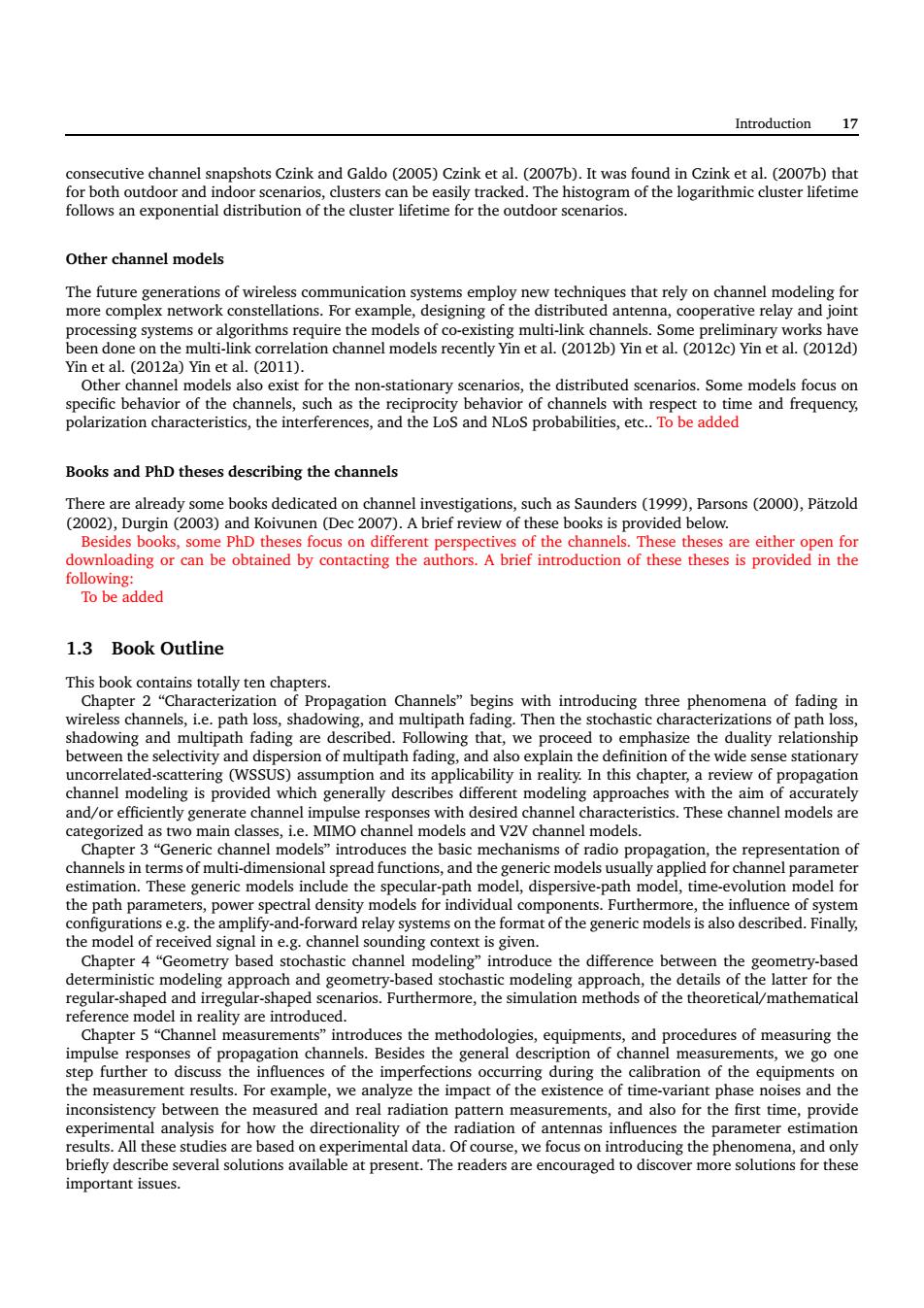正在加载图片...

Introduction 17 ve cha in Czink et al.(2007b)tha follows an exponential distribution of the cluster lifetime for the outdoor scenarios Other channel models The future generations of wireless communication systems employ new techniques that rely on channel modeling for more complex network constellations.For example,designing of the distributed antenna,cooperative relay and joint Yin et al.(2012a)Yin et al.(2011). polarization characteristics,the interferences,and the Los and NLoS probabilities,etc..To be added Books and PhD theses describing the channels There are already some books dedicated on channel inve stigations,such as Saunders(1999),Parsons(2000),Patzold (02),Durgin (003)and Koivunen Dec07).A brief review of these books is provided below. 1.3 Book Outline This book shado ing,and mu ing.The the stocha ns of path assumptio its app bility in re and/or efficiently genera e channel im onses with desired channel characteristics.These channel models are categorize main class MIMO chann chann dels ag tationo channels in t ns of multi-dimensional spre ad functions,and the ger ric models usually nnel param hed-forward format. model of eceived signal e.g.chann our ng context is given the dif deterministic ach and geometry-based stochastic modelin enarios.Furthermore,the simulation methods of the theoretical/mathematical Cha s"introduces the methodologies.equipments.and procedures of measuring the tion ch the measur inconsistency bet the measured surements, nd also for the first time,provide are hased on exr briefly describe several solutions available at present.The readers are encouraged to discover more solutions for these important issues Introduction 17 consecutive channel snapshots Czink and Galdo (2005) Czink et al. (2007b). It was found in Czink et al. (2007b) that for both outdoor and indoor scenarios, clusters can be easily tracked. The histogram of the logarithmic cluster lifetime follows an exponential distribution of the cluster lifetime for the outdoor scenarios. Other channel models The future generations of wireless communication systems employ new techniques that rely on channel modeling for more complex network constellations. For example, designing of the distributed antenna, cooperative relay and joint processing systems or algorithms require the models of co-existing multi-link channels. Some preliminary works have been done on the multi-link correlation channel models recently Yin et al. (2012b) Yin et al. (2012c) Yin et al. (2012d) Yin et al. (2012a) Yin et al. (2011). Other channel models also exist for the non-stationary scenarios, the distributed scenarios. Some models focus on specific behavior of the channels, such as the reciprocity behavior of channels with respect to time and frequency, polarization characteristics, the interferences, and the LoS and NLoS probabilities, etc.. To be added Books and PhD theses describing the channels There are already some books dedicated on channel investigations, such as Saunders (1999), Parsons (2000), Pätzold (2002), Durgin (2003) and Koivunen (Dec 2007). A brief review of these books is provided below. Besides books, some PhD theses focus on different perspectives of the channels. These theses are either open for downloading or can be obtained by contacting the authors. A brief introduction of these theses is provided in the following: To be added 1.3 Book Outline This book contains totally ten chapters. Chapter 2 “Characterization of Propagation Channels” begins with introducing three phenomena of fading in wireless channels, i.e. path loss, shadowing, and multipath fading. Then the stochastic characterizations of path loss, shadowing and multipath fading are described. Following that, we proceed to emphasize the duality relationship between the selectivity and dispersion of multipath fading, and also explain the definition of the wide sense stationary uncorrelated-scattering (WSSUS) assumption and its applicability in reality. In this chapter, a review of propagation channel modeling is provided which generally describes different modeling approaches with the aim of accurately and/or efficiently generate channel impulse responses with desired channel characteristics. These channel models are categorized as two main classes, i.e. MIMO channel models and V2V channel models. Chapter 3 “Generic channel models” introduces the basic mechanisms of radio propagation, the representation of channels in terms of multi-dimensional spread functions, and the generic models usually applied for channel parameter estimation. These generic models include the specular-path model, dispersive-path model, time-evolution model for the path parameters, power spectral density models for individual components. Furthermore, the influence of system configurations e.g. the amplify-and-forward relay systems on the format of the generic models is also described. Finally, the model of received signal in e.g. channel sounding context is given. Chapter 4 “Geometry based stochastic channel modeling” introduce the difference between the geometry-based deterministic modeling approach and geometry-based stochastic modeling approach, the details of the latter for the regular-shaped and irregular-shaped scenarios. Furthermore, the simulation methods of the theoretical/mathematical reference model in reality are introduced. Chapter 5 “Channel measurements” introduces the methodologies, equipments, and procedures of measuring the impulse responses of propagation channels. Besides the general description of channel measurements, we go one step further to discuss the influences of the imperfections occurring during the calibration of the equipments on the measurement results. For example, we analyze the impact of the existence of time-variant phase noises and the inconsistency between the measured and real radiation pattern measurements, and also for the first time, provide experimental analysis for how the directionality of the radiation of antennas influences the parameter estimation results. All these studies are based on experimental data. Of course, we focus on introducing the phenomena, and only briefly describe several solutions available at present. The readers are encouraged to discover more solutions for these important issues